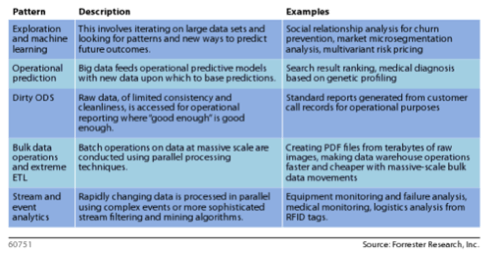Last week, Forrester Research tries to grok Big Data with a report entitled, Expand Your Digital Horizon With Big Data. And while it is somewhat amusing to see how they approach the topic as they would a new network router or new version of Office, ultimately the report falls somewhat flat, especially for those of us that have been using these tools and writing about the subject for many years now.

While you can obtain the report here for $500 or if you are a client of theirs, I’ll save you the money and highlight just a few areas that are of interest. You can also check out Brian Hopkins’ blog entry here (he was one of the co-authors).
The report mentions five common Big Data usage patterns, as you can see in the table below. Some of these are just common sense, and already deployed by many companies across the Internet.

There were some insightful things to consider, though.
- First, it isn’t just a matter of scaling up your existing databases, although that can be a temporary fix to your performance problems. The best Big Data solutions are where you need new ways of thinking about your data that just throwing hardware at things isn’t going to help. You might need to visualize your data in different ways, or start asking different questions.
- Second, you may have multiple truths you are going after. Many firms depend on a single consistent version of the truth stemming from a centralized data repository, the report states. That might not be possible as your data scales up and is subject to different interpretations, or what Forrester calls localized or relative truths. Perhaps we need some kind of Colbert-like truthiness metric to figure this all out.
- Third, you don’t always have perfect business process knowledge. The more complex your business processes, the less you might really understand their relationships, and Big Data can be handy at revealing these insights and help firms deal with processes that can’t be easily tamed.
- Finally, speed can trump accuracy. “Sometimes two plus two can equal 3.9, and that is good enough,” they state. For certain kinds of analysis, being able to quickly respond to a competitive threat, or to design a new marketing campaign to counter a Twitter-storm of protests, is more important than being spot on.
One thing is clear: Big Data is here to stay, and firms who haven’t yet dipped their toes into this pool will be at a disadvantage in the coming years.

















